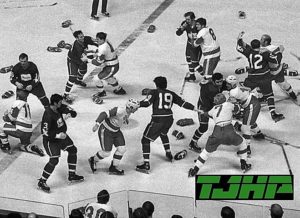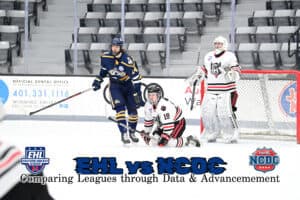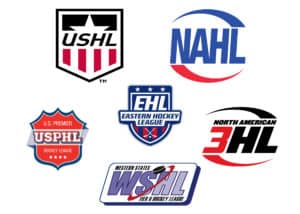As a hockey independent news and content entity, we have no dog in the fight about which league and programs advance the most players to college hockey roster spots. It is our belief that we are the only entity in the world that breaks down and tracks every single NCAA freshman at the NCAA Division I, II and III levels.
It is also our contention that this is the most important data that exists when considering a plan for a college-bound hockey player, especially if headed toward Division II and III. If you are a pay-to-play Junior competitor, with designs on an NCAA roster spot, you don’t need to pay an additional chunk of change each month to a player advisor. You only need a combination of research and discipline. The former so you can apply your end-goal plan to an organization and the latter so you can avoid joining a team, with very little history in advancing players, simply because you are being recruited.
This data should matter more than marketing materials, vague claims of advancement prowess and even more than word of mouth. Word of mouth will speak to the player environment, which is also important, but in terms of performance, this data is inarguable.
Advancement Defined
TJHP defines “advancement” as moving directly to college hockey from a team and league. This differs from “commitment,” which is important and interesting but not binding. If you really do your research you’ll notice that these numbers differ from the number of advancements and/or commitments some organizations and leagues will display on their websites and in their marketing materials. Embellishing advancement and commitment numbers is a time-honored tradition because let’s face it … who’s going to go through all the NCAA rosters 6-12 months after the commitments are announced? TJHP has the answer to that question.
Now that we’ve pumped our tires for four paragraphs on the importance of TJHP in the world of college-bound hockey — it’s time to dig into the data.
NCAA Hockey Advancement From Junior Hockey Leagues
The graphic below unveils the league and level advancement results for this year’s 741 NCAA Division II and III freshmen (and yes, before you start emailing us, there are still seven NCAA Division II hockey teams in existence). Most notably, this is the first time in five years of compiling this data that the Eastern Hockey League (EHL) has not been No. 1 in overall advancements.
The USPHL Premier (USPHL-P) ascended to this year’s top spot by gradually building its numbers through a transition period that saw that league’s 2017 creation and implementation of the tuition-free National Collegiate Development Conference (NCDC). The NCDC involves most of the USPHL organizations that previously led the way in pay-to-play advancements in the USPHL.
The organizations that have NCDC teams have clearly settled back into the business of offering both options. It’s not easy to create a new, higher level of play and attempt to continue the previously offered level of play with any sort of proficiency. Although illogical, most players, when cut by a tuition-free team, will go elsewhere for a pay-to-play option because of the stigma of being on the “second” team in an organization.
Despite finishing in the No. 2 spot in overall advancements the EHL still owns a commanding lead in advancements per team with a mark of 6.33. Last year’s 114 EHL advancements were spread out over 18 teams while the USPHL-P’s 120 were spread out over 51 teams (2.35 avg.). Interestingly, the second-best per-team production is owned by the NCDC with a mark of 5.75 per team (69 from 12 teams).
These per-team numbers give a more accurate portrayal of overall league proficiency but at the end of the day, the advancements are all related to teams and organization, regardless of league membership. Playing in the top league, but for a team with no history in advancements, isn’t going to help you advance. The leagues get more credit than they deserve in this discussion because a league can only provide a stable infrastructure for events and information. NCAA coaches don’t contact leagues to recruit players and vice versa.

Junior Hockey Leagues with 2019 NCAA DII & DIII Advancements
The teams that lead the way in advancement are fairly consistent year in and year out.
The EHL’s New Hampshire Avalanche, led by longtime Tier III head coach and general manager Chris Cerrella, again set the mark in 2019 with 13 advancements (see graphic below). The Avalanche are owned by Mario Martiniello, who is the former head coach and general manager of the Boston Jr. Rangers of the EHL. When he purchased the Ice Den in 2017 in Hooksett, N.H., he wooed Cerrella from his previous post with the Hartford Jr. Wolfpack purchased an EHL franchise and came out of the gate with two league titles in the first two years of existence, in addition to the NCAA advancement bragging rights.

This is the third straight year a Cerrella-guided team has won this national crown while Cerrella-guided teams have also racked up a national-best 71 advancements over the past five years.
There is a four-way tie for the runner-up slot as the Northern Cyclones and Hampton Roads Whalers of the USPHL-P, the New Hampshire Jr. Monarchs of the NCDC and the Philadelphia Revolution of the EHL are all tied with 11.
The top 10 has four USPHL-P teams, four EHL teams and two tuition-free teams (Monarchs and Springfield Jr. Blues of the North American Hockey League).
Because a lot of organizations have more than one college-bound team we also track advancement data in that manner. The national leader in this category is shared by the Northern Cyclones and the New Hampshire Jr. Monarchs, led by longtime coaches/general managers Bill Flanagan and Ryan Frew, respectively.
Both the Cyclones and Monarchs used three teams to get to their number of 17. The Cyclones had 11 USPHL-P advancements, five NCDC advancements, and one 18U AAA. The Monarchs were the reverse with 11 NCDC advancements, five USPHL-P advancements, and one 18U AAA.

The South Shore Kings of the USPHL/NCDC tied the EHL’s Avalanche with 13, followed by the USPHL/NCDC’s Islanders Hockey Club with 12 to round out the top five.
Over the past five years
We have tracked overall advancement by organizations, instead of by team, because there has been movement between leagues, consolidation of some league divisions and expansion of other league divisions.
The reason we have combined the Hartford Jr. Wolfpack and the New Hampshire Avalanche is because of Cerrella’s position as head coach and general manager of both teams over the last five years. Of the top 10 organizations, he is the only coach who made a lateral movement from one pay-to-play team to another.
Division II and III advancement is largely due to each team’s head coach, as evidenced by his ability to immediately perform at the same level as the Avalanche as an expansion team. Regarding the data below, Cerrella was the head coach of the Wolfpack in 2015-17 and has spent the past two years with the Avalanche.
Out of the top 10 organization, there are four EHL programs (Hartford/Avalanche, Walpole Express, Boston Junior Rangers and Valley Jr. Warriors), three USPHL/NCDC organizations (South Shore, Islanders Hockey Club, and Springfield Pics) and three organizations who left the EHL to join the USPHL/NCDC after the 2016-17 season (Northern Cyclones, Monarchs, and Boston Bandits).

The fact the Cyclones, Monarchs, and Bandits have been top five teams in both leagues is a good example of why the team and the coach are much bigger factors than the league membership.
Check back tomorrow for our breakdown of NCAA Division I advancement data, in addition to more NCAA Division II and III information.
Jeff Nygaard is the editor of The Junior Hockey Podcast. He covers Junior and college-bound hockey as a traditional “beat,” in addition to breaking news stories during the course of the year
He has a vast amount of experience on the business and organizational side of the sport as a former owner-operator of two Junior organizations two youth clubs and has served as executive director or commissioner of the Eastern Hockey League and the United States Premier Hockey League.
A Fergus Falls, Minn., native, Nygaard grew up playing for the Fergus Falls Youth Hockey Association, Fergus Falls High School, Fergus Falls Community College and North Dakota State University programs. He can be reached at info@juniorhockeyhub.com for questions, story ideas, and anonymous tips.











